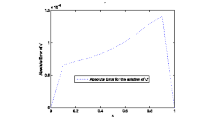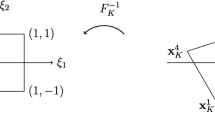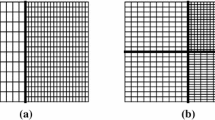Abstract
High order finite difference WENO methods have the advantage of simpler coding and smaller computational cost for multi-dimensional problems, compared with finite volume WENO methods of the same order of accuracy. However a main restriction is that conservative finite difference methods of third and higher order of accuracy can only be used on uniform rectangular or smooth curvilinear meshes. In order to overcome this difficulty, in this paper we develop a multidomain high order WENO finite difference method which uses an interpolation procedure at the subdomain interfaces. A simple Lagrange interpolation procedure is implemented and compared to a WENO interpolation procedure. Extensive numerical examples are shown to indicate the effectiveness of each procedure, including the measurement of conservation errors, orders of accuracy, essentially non-oscillatory properties at the domain interfaces, and robustness for problems containing strong shocks and complex geometry. Our numerical experiments have shown that the simple and efficient Lagrange interpolation suffices for the subdomain interface treatment in the multidomain WENO finite difference method, to retain essential conservation, full high order of accuracy, essentially non-oscillatory properties at the domain interfaces even for strong shocks, and robustness for problems containing strong shocks and complex geometry. The method developed in this paper can be used to solve problems in relatively complex geometry at a much smaller CPU cost than the finite volume version of the same method for the same accuracy. The method can also be used for high order finite difference ENO schemes and an example is given to demonstrate a similar result as that for the WENO schemes.
Similar content being viewed by others
References
Balsara, D., and Shu, C.-W. (2000). Monotonicity preserving weighted essentially non-oscillatory schemes with increasingly high order of accuracy. J. Comput. Phys. 160, 405-452.
Berger, M., and Colella, P. (1989). Local adaptive mesh refinement for shock hydrodynamics. J. Comput. Phys. 82, 64-84.
Casper, J., Shu, C.-W., and Atkins, H. L. (1994). Comparison of two formulations for high-order accurate essentially nonoscillatory schemes. AIAA J. 32, 1970-1977.
Del Zanna, L., Velli, M., and Londrillo, P. (1998). Dynamical response of a stellar atmosphere to pressure perturbations: Numerical simulations. Astron. Astrophys. 330, L13-L16.
Friedrichs, O. (1998). Weighted essentially non-oscillatory schemes for the interpolation of mean values on unstructured grids. J. Comput. Phys. 144, 194-212.
Grasso, F., and Pirozzoli, S. (2000). Shock-wave-vortex interactions: Shock and vortex deformations, and sound production. Theor. Comp. Fluid Dyn. 13, 421-456.
Grasso, F., and Pirozzoli, S. (2000). Shock wave-thermal inhomogeneity interactions: Analysis and numerical simulations of sound generation. Phys. Fluids 12, 205-219.
Harten, A., Engquist, B., Osher, S., and Chakravarthy, S. (1987). Uniformly high order essentially non-oscillatory schemes, III. J. Comput. Phys. 71, 231-303.
Hu, C., and Shu, C.-W. (1999). Weighted essentially non-oscillatory schemes on triangular meshes. J. Comput. Phys. 150, 97-127.
Jiang, G., and Peng, D.-P. (2000). Weighted ENO schemes for Hamilton–Jacobi equations. SIAM J. Sci. Comput. 21, 2126-2143.
Jiang, G., and Shu, C.-W. (1996). Efficient implementation of weighted ENO schemes. J. Comput. Phys. 126, 202-228.
Jiang, G., and Wu, C.-C. (1999). A high order WENO finite difference scheme for the equations of ideal magnetohydrodynamics. J. Comput. Phys. 150, 561-594.
Le Veque, R. J. (1990). Numerical Solutions for Conservation Laws, Birkhäuser Verlag.
Liang, S., and Chen, H. (1999). Numerical simulation of underwater blast-wave focusing using a high-order scheme. AIAA J. 37, 1010-1013.
Liska, R., and Wendroff, B. (1998). Composite schemes for conservation laws. SIAM J. Numer. Anal. 35, 2250-2271.
Liska, R., and Wendroff, B. (1999). Two-dimensional shallow water equations by composite schemes. Int. J. Numer. Meth. Fluids 30, 461-479.
Liu, X.-D., Osher, S., and Chan, T. (1994). Weighted essentially non-oscillatory schemes. J. Comput. Phys. 115, 200-212.
Montarnal, P., and Shu, C.-W. (1999). Real gas computation using an energy relaxation method and high order WENO schemes. J. Comput. Phys. 148, 59-80.
Noelle, S. (2000). The MoT-ICE: a new high-resolution wave-propagation algorithm for multidimensional systems of conservation laws based on Fey's method of transport. J. Comput. Phys. 164, 283-334.
Shi, J., Hu, C., and Shu, C.-W. (2002). A technique of treating negative weights in WENO schemes. J. Comput. Phys. 175, 108-127.
Shu, C.-W. (1998). Essentially non-oscillatory and weighted essentially non-oscillatory schemes for hyperbolic conservation laws. In Cockburn, B., Johnson, C., Shu, C.-W., and Tadmor, E. (Quarteroni, A. (ed)), Advanced Numerical Approximation of Nonlinear Hyperbolic Equations, Lecture Notes in Mathematics, Vol. 1697, Springer, pp. 325-432.
Shu, C.-W. (1999). High order ENO and WENO schemes for computational fluid dynamics. In Barth, T. J., and Deconinck, H. (eds.), High-Order Methods for Computational Physics, Lecture Notes in Computational Science and Engineering, Vol. 9, Springer, pp. 439-582.
Shu, C.-W. High order finite difference and finite volume WENO schemes and discontinuous Galerkin methods for CFD. Int. J. Comput. Fluid Dyn., to appear.
Shu, C.-W., and Osher, S. (1988). Efficient implementation of essentially non-oscillatory shock capturing schemes. J. Comput. Phys. 77, 439-471.
Shu, C.-W., and Osher, S. (1989). Efficient implementation of essentially non-oscillatory shock capturing schemes, II. J. Comput. Phys. 83, 32-78.
Part-Enander, E., and Sjogreen, B. (1994). Conservative and non-conservative interpolation between overlapping grids for finite volume solutions of hyperbolic problems. Computers Fluids 23, 551-574.
Quemere, P., Sagaut, P., and Couailler, V. (2001). A new multidomain/multiresolution method for large-eddy simulation. Int. J. Numer. Meth. Fluids 36, 391-416.
Tang, H.-S., and Zhou, T. (1999). On nonconservative algorithms for grid interfaces. SIAM J. Numer. Anal. 37, 173-193.
Woodward, P., and Colella, P. (1984). The numerical simulation of two-dimensional fluid flow with strong shocks. J. Comput. Phys. 54, 115-173.
Yang, J., Yang, S., Chen, Y., and Hsu, C. (1998). Implicit weighted ENO schemes for the three-dimensional incompressible Navier–Stokes equations. J. Comput. Phys. 146, 464-487.
Zhang, Y.-T. and Shu, C.-W. High order WENO schemes for Hamilton–Jacobi equations on triangular meshes. SIAM J. Sci. Comput., to appear.
Author information
Authors and Affiliations
Rights and permissions
About this article
Cite this article
Sebastian, K., Shu, CW. Multidomain WENO Finite Difference Method with Interpolation at Subdomain Interfaces. Journal of Scientific Computing 19, 405–438 (2003). https://doi.org/10.1023/A:1025372429380
Issue Date:
DOI: https://doi.org/10.1023/A:1025372429380




